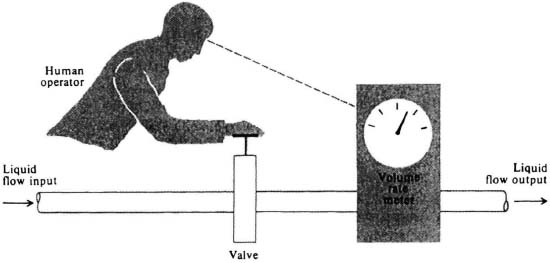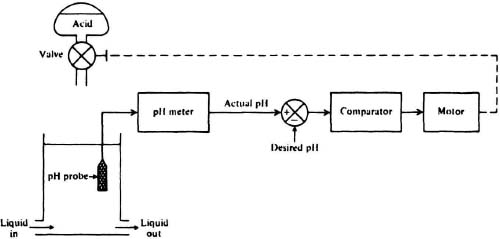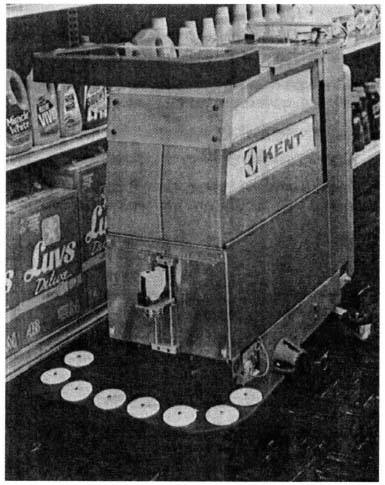PROBLEMS
1.1. Figure P1.1 illustrates the control system for controlling the angular position of a ship’s heading. The desired heading, which is determined by the gyroscope setting, is the reference. An electrical signal proportional to the reference is obtained from a resistor that is fixed to the ship’s frame. Qualitatively explain how this control system operates in following a command for a southbound direction.
Figure p1.1
1.2. Explain how the rudder positioning system discussed in Problem 1.1 can be modified to become a closed-loop control system.
1.3. An electric hot-water heater is illustrated in Figure P1.3. The heating element is turned on and off by a thermostatic switch in order to maintain a desired temperature. Any demand for hot water results in hot water leaving the tank and cold water entering. Draw the simple functional block diagram for this closed-loop control system and qualitatively explain how it operates if the desired temperature of the thermostat is changed.
1.4. Explain how the system discussed in Problem 1.3 operates if the ambient temperature surrounding the tank suddenly changes. Refer to the block diagram.
1.5. Figure P1.5 illustrates a control system using a human operator as part of the closed-loop control system. Draw the block diagram of this liquid volume rate control system.
Figure p1.5
1.6. Devise a system that can control the speed of an internal-combustion engine in accordance with a command in the form of a voltage. Explain the operation of your system.
1.7. Devise a system that can control the position, rate, and acceleration of an elevator used in an apartment house. What specifications or limits would you place on the position, velocity, and acceleration capabilities of the system?
1.8. For the control system devised in Problem 1.7, describe what happens when a man weighing 200 lb enters the elevator that has stopped at one of the floors of the apartment building. Utilize a functional block diagram.
1.9. The economic model illustrated in Figure P1.9 illustrates the relationship between wages, prices, and cost of living. Note that an automatic cost of living increase results in a positive feedback loop. Indicate how additional feedback loops in the form of legislative control can stabilize the economic system.
Figure P1.9
1.10. Explain what happens to the automatic position control system illustrated in Figure 1.20 if the speed-measuring device fails. Can the system still operate?
1.11. Determine what happens in the autopilot system illustrated in Figure 1.23 if the aircraft suddenly enters a turbulent atmosphere.
1.12. Modify the block diagram of the attitude-control system of the space vehicle illustrated in Figure 1.16, to allow for sudden failure of the computer and manual control of the vehicle.
1.13. The pH factor of a liquid is a very important factor to be controlled in chemical process control systems. Figure P1.13 illustrates an example of a system which controls the pH factor of a liquid flowing through a tank. The pH probe measures the actual pH level and compares it with the desired pH level. If the liquid in the tank does not have the required acidic level, then the motor adjusts the valve permitting additional acid to enter the tank. The limitation of the system shown is that it does not have any provisions for adding a base solution in the event that the liquid in the tank is too acidic. Modify this control system so that it could add an acid or a base to the liquid in the tank, and achieve the desired pH factor for all kinds of liquid pH factors.
Figure P1.13
1.14. The actual sales price of a commodity in a free economic market is governed by the law of supply and demand that states that the market demand for the item increases as its price decreases. In addition, this concept states that an equilibrium sales price is achieved when the supply is equal to the demand. The control engineer can represent this concept as a feedback system with the actual sales price being represented as the output, and the desired market sales price change as the command input. Draw the block diagram for this economic system which includes the supplier, demander, prices, and market. Under which conditions is an equilibrium operation of supply and demand achieved?
1.15. The level of a liquid in a chemical process control system must be maintained constant within a narrow range. In order to achieve this, a float-operated device is used to sense the level of liquid and control the valve opening which determines the flow of liquid into the tank to replace that which is consumed in the process. Show how this float-valve control system can be operated in a closed-loop control system.
1.16. Repeat Problem 1.15 if the level of the liquid is controlled by a float switch which opens the valve whenever the level of the liquid reaches a certain predetermined level. The valve is automatically closed by a timer switch four minutes after it is opened by the float switch, even though the liquid may be more or les than the desired level. Is this an open-loop or closed-loop control system?
1.17. Figure P1.17 represents the general concept of a command, control, and communication system which is essentially a closed-loop system having the capability of changing an environment based on information presented to a central human controller [43]. The decisions are based on information obtained by sensors, communicated by a data link to a data processor, and appropriately displayed to a commander who then closes the loop by communicating commands to the personnel and equipment at his disposal in order to change the overall environment. A complete command, control, and communication system includes all subsystems, related facilities, equipment, material, services, and personnel required to operate the self-sufficient system. From a functional systems engineering viewpoint, a command, control, and communication system includes sensors, communications, data processing, displays, and the man-machine interface. Synthesize command and control systems for the following applications:
(a) An airline reservations system for a trunk carrier that has one central terminal, five major terminals, and six minor terminals.
(b) A worldwide satellite communications system containing two major land stations and one major shipborne station.
(c) A strategic command, control, and communication system responsible for the defense of the northeastern section of the United States.
(d) An antisubmarine warfare system aboard a destroyer.
(e) A ground traffic control system for a city of 4 million population.
(f) A police command system controlling the operation of 20 stationary posts and 40 mobile units from one central headquarters station.
Figure P1.17 General concept of a closed-loop command, control, and communication system [43].
1.18. Robots are being used to a greater degree in almost all aspects of industry. Figure P1.18 shows a photograph of RoboKent™, an automatic floor scrubber for commercial cleaning of supermarkets, warehouses, airports, etc. It has been developed by Transitions Research Corporation (TRC) [44] under a contract from Electrolux AB of Sweden, through its U.S. subsidiary, Kent Company, manufacturer of floor cleaning equipment. The machine is a Kent KA-201 BST fitted with Transitions Research Corporation’s drive, scanning, and sensing system. It is designed to automatically clean 100 percent of the floor area in simple unobstructed environments, and 70 percent in more complicated areas. The user need only walk the machine through the middle of the area to be cleaned one time, and then RoboKent will execute its preprogrammed cleaning patterns automatically. This robot contains 16 ultrasonic range sensors, bumpers, a light curtain, dead-reckoning, and a rate gyro for navigation. Draw a block-diagram representation of this robot with the input being represented as the desired position of the robot, and the output being the actual position of the robot. Is this an open-loop or closed-loop control system?
Figure P1.18 Photograph of RoboKent™, an automatic floor scrubber for commercial cleaning of supermarkets, warehouses, airports, and so on. (Courtesy of TRC)
1.19. An automobile leasing agency desires to develop a control-system model which represents the actual number of automobiles being leased as an output and compares it with the desired automobiles being leased as an input. In this control system model, the management of this automobile leasing agency determines the rate of automobiles being leased based on their maintenance facilities, which service the returned automobiles, and the availability of automobiles in their agency. The Maintenance Department then uses the rate established by the management to hire a sufficient staff and buy the necessary support equipment. Draw a block-diagram representation which illustrates the input, the output, management, and the Maintenance Department as blocks of this control system. In addition, show the return rate of automobiles, the rate of leased automobiles, and the net rate of automobiles being leased.
1.20. The organization of an engineering corporation is a feedback process in which the desired product represents the reference input, and the actual resulting product represents the output. The groups involved in the process include the management of the engineering organization, which monitors continually the process and compares the desired product and the actual resulting product, and the following departments:
• Research and Development
• Laboratory Development
• Laboratory Test
• Prototype Development
• Prototype Test
• Product Design
• Production Department
• Quality Assurance and Test
Draw a feedback control system illustrating the representation of this control system. In addition, indicate any inner feedback loops which occur in this process.







